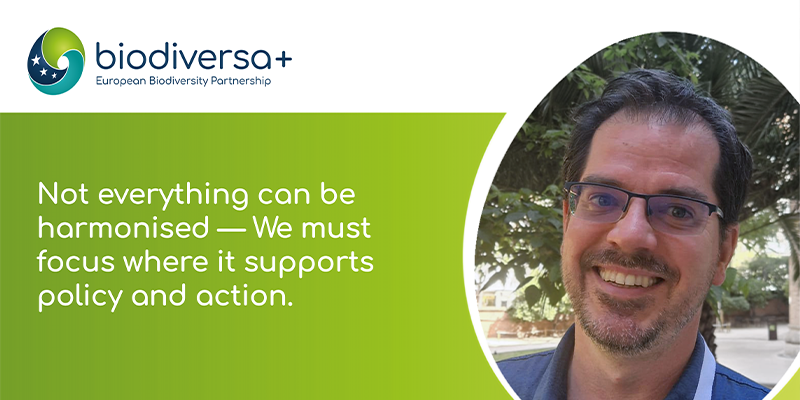Europe is rich in biodiversity—and in monitoring schemes! But this diversity of protocols and priorities creates major challenges for collecting and comparing data at scale. On the sidelines of our Barcelona events, we spoke with Guillaume Body, task leader at Biodiversa+, about how his work with Michelle Silva del Pozo and their team is helping lead efforts to harmonise biodiversity monitoring. He shared insights on why harmonisation matters, why it’s so complex, and how Europe can move forward.
Highlights:
- Europe’s diverse biodiversity monitoring schemes require urgent harmonisation for effective data comparison, efficient conservation, and coordinated transnational action.
- Harmonisation is complex due to existing protocols and ecological differences, leading to approaches like aligning targets and piloting dual national/harmonised protocols.
- Biodiversa+ is leading efforts to build a coordinated monitoring ecosystem by supporting thematic hubs and developing tools like BioDash.
Why harmonise?
“Monitoring must match the level at which action is taken. If conservation is transnational, monitoring should be too,” says Guillaume. Without shared definitions and protocols, it’s hard to compare data, detect continent-wide trends, or coordinate responses.
Harmonisation isn’t just about better data, it also improves efficiency. Shared protocols support the development of common tools for data collection and analysis. “For example, the community monitoring terrestrial common birds has agreed on three main protocols, which makes developing shared tools much easier,” Guillaume explains.
Despite its benefits, harmonisation is easier said than done. “Some schemes have been running for 50 years. Changing protocols risks breaking valuable time series,” Guillaume notes. Geographic and ecological differences add another layer of difficulty: What works in one region may not suit another. Identifying insect pollinators along transects, for example, is feasible in Northern Europe but far more complex in the Mediterranean.
Lessons from climate monitoring
Climate science offers a compelling parallel. Decades of coordinated data collection have enabled large-scale insights. Biodiversity monitoring is more fragmented, but harmonisation could deliver similar benefits. “In the marine realm, harmonising protocols at the regional sea level, such as in the Baltic, the North Sea, and the Mediterranean, has enabled the clear detection of climate impacts, something only possible at a transnational scale,” Guillaume says.
Yet biodiversity is more local and varied than climate. “There is no one biodiversity in the world,” Guillaume adds. “Even if we face similar threats, actions must be locally tailored.” Europe offers an essential framework for coordination: large enough to address transboundary challenges, but still grounded in regional realities. In practice, however, coordination at the biogeographical or sub-European level may often prove more effective, providing the ecological nuance needed for meaningful implementation within a shared European vision.
Another plus is that biodiversity often responds faster and more directly to conservation efforts. “You can usually see the impact of local policies within a few years, which is quite different from climate change that happens more slowly and over broader areas,” Guillaume notes.
Making it work in practice
Sometimes, harmonisation isn’t about using the same methods, but aligning the data we aim to collect. “We may need to shift from harmonising protocols to harmonising targets,” Guillaume suggests.
France is currently piloting a dual approach: national protocols are run alongside simplified, harmonised ones at the same sites. “For instance, we check whether the protocol from the Biodiversa+ pilot on soil monitoring produces similar results to our current national protocol and compare costs,” he explains. If successful, this could pave the way for broader adoption of lighter protocols while retaining detailed monitoring at key sites.
The marine realm shows how planning and strong data systems support effective harmonisation. “You need a lot of coordination and money to go out at sea, so marine programmes are more structured,” Guillaume says. In contrast, land-based monitoring is easier to launch, but also more fragmented.
Organising Europe’s monitoring ecosystem
Europe is home to around 60 thematic hubs, expert groups working on specific taxa or ecosystems. Many already work on harmonisation, but often in parallel. “Without coordination, we risk duplication and incompatibility,” warns Guillaume.
What’s needed is a clear, jointly recognised mandate to coordinate these hubs, allocate roles, and prevent overlap. Guillaume envisions “massifying” harmonisation by giving all hubs a standard template for data standards and responsibilities. He adds, “Providing support to these hubs, such as investing around €100,000 per hub per year, totalling €6 million annually, would considerably accelerate the harmonisation of monitoring efforts.”
The upcoming European Biodiversity Observation Coordination Centre (EBOCC) could also help by providing mandates, templates, and funding on the long term. But as Guillaume cautions: “We cannot wait for it. We need to start now.”
In the meantime, Biodiversa+ is helping clarify what harmonisation means, from aligning targets to testing coordination in real-world settings. Another tool under development is BioDash. With thousands of monitoring schemes across Europe, many lack visibility or proper metadata. BioDash will give each scheme a clear identity: what it monitors, where, how, and which EBVs it contributes to. “This helps identify gaps, reduce duplication, and plan what to develop next,” says Guillaume.
Looking ahead
Setting clear priorities is essential. “We must focus on what is needed for policy action,” Guillaume emphasises. He adds, “When monitoring species or ecosystem trends, it’s crucial to understand how they relate to known pressures and policies, so we can generate clear, actionable insights within the resources available.”
Still, anticipating future needs remains a challenge. “We’re already struggling to monitor what’s currently required,” he says. However, identifying and tracking long-term pressures like climate and land-use change now can help build more future-proof monitoring systems.
The path forward may be complex, but the tools are emerging. What’s needed now is the commitment to use them. Without harmonisation, we risk knowing too little, too late: “Transnational coordination is not a luxury, but a necessity.”




